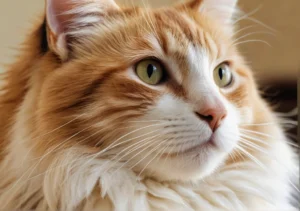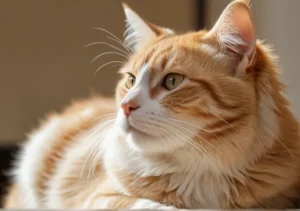Cats are known for their meticulous grooming habits, but what happens when they take it too far? Why do cats overgroom themselves?
Cat Overgrooming: Understanding the Habit
Normal Grooming Behavior:
Cats are famously clean animals, spending a significant portion of their day grooming themselves. This behavior isn’t just about looking good; it’s essential for their health and wellbeing. Regular grooming helps cats regulate their body temperature, distribute natural oils through their fur, and remove loose hair and dirt. Additionally, grooming plays a crucial role in maintaining a cat’s mental health, as it helps them relax and feel secure in their environment.
Causes of Overgrooming:
While grooming is a natural behavior for cats, overgrooming can signal an underlying issue. Stress, allergies, and medical problems are common reasons why cats may start overgrooming. If your feline friend is feeling anxious or overwhelmed, they may turn to excessive grooming as a coping mechanism. Allergies to food, parasites, or environmental factors can also lead to overgrooming. Furthermore, medical conditions such as skin infections or pain can cause cats to focus on grooming a particular area excessively.
Additional Unique Insight:
In addition to stress, allergies, and medical issues, boredom or lack of stimulation can also contribute to overgrooming in cats. Providing enrichment activities, interactive toys, and a stimulating environment can help prevent excessive grooming behavior in your furry companion. Remember, a mentally and physically engaged cat is a happy and healthy cat.
Behavioral Triggers: How do environmental factors and changes in routine play a role in prompting cats to overgroom?
Cats may overgroom themselves due to environmental stressors or changes in their routine. Moving to a new home, introducing a new pet, or modifications in their daily schedule can cause anxiety in cats, leading them to soothe themselves by excessive grooming. Additionally, boredom and lack of mental stimulation can also prompt a cat to groom obsessively. It’s essential to identify potential triggers and provide a comfortable and enriching environment to help alleviate stress and reduce overgrooming behaviors in your feline companion.
Health Concerns: Learn about potential health issues that can arise from excessive grooming, including skin irritation and the formation of hairballs.
Excessive grooming in cats can lead to skin irritation, hair loss, and the development of hairballs. When a cat licks or chews at its fur excessively, it can irritate the skin, causing redness, inflammation, and even raw spots. Moreover, grooming too frequently can result in the ingestion of a large amount of fur, increasing the likelihood of hairballs forming in the digestive tract. To prevent these health issues, it’s crucial to address the underlying cause of overgrooming and provide proper grooming tools and a balanced diet to support your cat’s overall well-being.
Additional unique insight: Regular grooming sessions with a brush or comb can help reduce the amount of loose hair on your cat’s coat, decreasing the risk of hairballs and skin irritation.
Management Strategies
Cats may overgroom themselves due to stress, anxiety, allergies, or skin conditions. To help your feline friend reduce overgrooming, create a stimulating environment with toys, scratching posts, and hiding spots. Additionally, try using interactive feeders to keep them mentally engaged. Regular grooming sessions where you brush your cat can also help reduce the need for excessive grooming. If the behavior persists, consult your veterinarian to rule out any underlying medical issues.
Effective Management Strategies: 1. Provide plenty of interactive toys and scratching posts. 2. Create a calm environment to reduce stress and anxiety. 3. Offer puzzle feeders to keep your cat mentally stimulated. 4. Regular grooming sessions to minimize the need for overgrooming. 5. Consult your vet to address any medical causes of overgrooming behavior.
Professional Help
If your cat’s overgrooming persists despite trying management strategies, it’s time to seek assistance from a veterinarian or behaviorist. These professionals can help identify any underlying medical issues causing the behavior and provide tailored solutions to address the problem. Don’t delay seeking help, as prolonged overgrooming can lead to skin irritation or infections that require medical treatment.
Signs It’s Time to Seek Professional Help: 1. Overgrooming continues despite trying management strategies. 2. Your cat shows signs of skin irritation or hair loss. 3. Behavior impacts your cat’s overall well-being. 4. Consultation with a veterinarian or behaviorist to address the issue effectively. 5. Prompt action can prevent further complications related to overgrooming.
For more information and guidance on managing your cat’s overgrooming behavior, consider consulting a certified feline behaviorist from reputable sources like the American Association of Feline Practitioners: American Association of Feline Practitioners
Prevention Tips: What steps can you take to prevent your cat from developing overgrooming tendencies in the first place?
Overgrooming in cats can be a troublesome habit that can lead to skin issues and discomfort for your furry friend. To prevent this behavior from arising, provide ample mental and physical stimulation for your cat. Engage in interactive play sessions, offer puzzle toys, or create new hiding spots for your cat to explore.
Maintaining a consistent grooming routine is essential in preventing overgrooming. Regularly brush your cat’s fur to help remove any loose hair that could trigger excessive grooming. Additionally, ensure your cat has a balanced diet to promote healthy skin and coat.
Creating a stress-free environment is crucial in preventing overgrooming in cats. Consider providing hiding spots, elevated perches, and multiple litter boxes to reduce any potential stressors. Regular veterinary check-ups can help identify any underlying medical issues that may be contributing to overgrooming.
Furthermore, limit exposure to potential irritants such as harsh detergents, certain fabrics, or strong scents that could trigger excessive grooming behavior. Ensure your cat has access to clean water at all times to promote hydration, which is essential for healthy skin and coat.
Uncovering the Root Cause: Going Beyond the Surface of Cat Overgrooming
While overgrooming may seem like a simple grooming behavior, it can often be a sign of underlying issues that need to be addressed. One common cause of overgrooming in cats is stress or anxiety. Changes in the household, new pets, or loud noises can all trigger excessive grooming in sensitive cats.
Skin conditions such as allergies or parasites can also lead to overgrooming as the cat tries to alleviate discomfort. If overgrooming persists, it is essential to consult with a veterinarian to rule out any medical conditions.
Boredom or lack of mental stimulation can result in overgrooming as cats may turn to excessive grooming as a form of self-soothing. Providing interactive toys, scratching posts, and engaging with your cat regularly can help prevent this behavior.
Additionally, environmental factors such as temperature and humidity can play a role in triggering overgrooming. Ensure your cat has a comfortable and stress-free environment to reduce the likelihood of overgrooming. If the behavior persists, seeking professional advice from a veterinarian or feline behaviorist is recommended.
Alex, a passionate animal lover, has experience in training and understanding animal behavior. As a proud pet parent to two dogs and three cats, he founded AnimalReport.net to share insights from animal experts and expand his knowledge of the animal kingdom.




